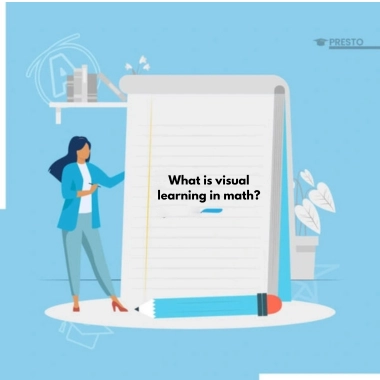Many people find math confusing because it often uses only numbers and words. But there is another way to learn math that helps ideas make more sense. It is called visual learning in math. Visual learning means using pictures, drawings, charts, and objects to explain math concepts. Instead of just reading numbers or listening to instructions, you can see how things work. This makes learning easier and more interesting for many students.
Here, you will learn what visual learning in math is, why it helps so much, examples you can try, and tips for making the most of this approach. You will also discover how platforms like Presto Experts can provide clear, step-by-step visual explanations if you need extra help mastering math concepts.
What Does Visual Learning in Math Mean?
Visual learning in math is when you use images and diagrams to understand math problems. It helps you “see” what is happening in a problem instead of only thinking about it in your head.
For example, if you are learning about fractions, you can look at a pizza divided into slices. Seeing the slices shows you exactly how fractions work.
Visual learning can include:
- Charts and graphs
- Number lines
- Shapes and models
- Pictures of real objects
- Drawings to solve word problems
When you use visuals, your brain connects ideas faster and remembers them longer.
Why Is Visual Learning in Math So Helpful?
Visual learning in math works well because our brains process images more easily than words alone. Research shows that when you look at a picture, you can understand the idea almost instantly.
Here are some reasons visual learning helps students:
Supports All Learning Styles: Not everyone learns the same way. Some people remember things by seeing them. Visuals help these students understand math better.
Builds Deeper Understanding: Instead of just memorizing formulas, you can see how math concepts work. For example, watching how the area changes when a shape grows helps you understand measurement.
Makes Problem-Solving Clear: Visuals break big problems into smaller steps. A drawing or chart shows what you need to do next.
Lowers Math Anxiety: Many students feel nervous about math. Pictures and diagrams make lessons less stressful and more friendly.
Increases Participation: When you use visuals, you feel more involved. Drawing, modeling, and building help you stay focused and interested.

Examples of Visual Learning in Math
Here are some common ways teachers use visual learning in math:
Number Lines
A number line is a straight line with numbers marked on it. It helps you see where numbers belong and how they relate to each other.
Example: If you want to add 3 + 4, you start at 3 on the line and move 4 spaces forward to land on 7.

Base Ten Blocks
These are small blocks that show ones, tens, hundreds, and thousands. They help you understand place value and how numbers build up.
Example: To show 325, you use 3 hundred blocks, 2 ten blocks, and 5 ones.
Fraction Circles and Bars
Fractions can be hard to picture. Fraction circles and bars show parts of a whole clearly.
Example: If you have a circle cut into 4 pieces, shading 1 piece shows 1/4.
Graphs and Tables
Graphs turn data into visuals you can compare. Tables organize numbers so you can see patterns.
Example: A bar graph can show how many books each student read in a month.
Geometric Models
Shapes and 3D models help you learn about area, perimeter, and volume.
Example: A cube shows how all sides are equal, and unfolding it teaches about nets.
Visual Problem-Solving
Drawing pictures can help solve tricky word problems.
Example: If 12 apples are shared by 4 friends, drawing 4 circles and putting apples in them shows each friend gets 3 apples.
If you’re exploring visual methods, it’s also helpful to look beyond the classroom. Many learners combine visual learning with online resources that guide them step by step, especially in complex subjects like math, accounting, and statistics. For instance, some students use Best Online Class Help Services for Accounting, Biology, Business, CIPD, Math, SPSS Statistics, and Computer Programming, which offer on-demand support whenever you feel stuck. Platforms like Presto Experts are highly trusted by learners who want clear, visual explanations at their own pace.
Benefits of Visual Learning in Math
When you use visual learning in math, you get many helpful benefits that make math easier and more interesting.
Better Memory
When you look at pictures or diagrams, your brain remembers them longer than if you just read words. For example, if you see a chart showing fractions, it is easier to recall later when you solve a problem.
Stronger Thinking Skills
Visual learning helps you spot patterns and make connections. When you look at graphs or models, you learn to compare numbers and see how they fit together. This makes your thinking skills sharper and more logical.
More Confidence
Math can feel hard sometimes. When you use visuals, you can see exactly what is happening in each step. This makes problems look less scary and helps you think good when you try new math problems.
Clear Communication
Visuals help you explain your work clearly. If you draw a picture or use a chart, you can show your teacher or classmates exactly how you solved a problem. This way, everyone understands your thinking.
Higher Engagement
Visuals make math more fun and interesting. When you can look at colorful graphs or use blocks and shapes, you feel more excited to learn. This keeps you focused and helps you pay attention longer.
Read Also: What is the 123 method of studying?
Tips for Using Visual Learning in Math
Here are some tips you can follow to get the most out of visual learning:
- Use Simple Visuals: Make sure your drawings and diagrams are clean and not too crowded. Simple visuals are easier to understand and remember.
- Create Your Own Drawings: When you draw pictures or models by yourself, you understand the math better. Try drawing a number line or a shape to show what is happening in the problem.
- Use Real-Life Objects: You can use everyday things, like coins, buttons, measuring cups, or building blocks, to learn math. These objects help you see how numbers work in real life.
- Try Technology: There are many apps and websites that use visuals to teach math. Interactive games, videos, and digital charts can help you learn in a fun way.
- Combine Visuals with Explanations: Whenever you draw or look at a diagram, say out loud or write down what it shows. This helps you understand it clearly and remember it later.
- Practice Often: The more you use visuals, the stronger your math skills will become. Try to use them often when you study or do homework. Over time, you will see that math gets easier.
Visual Learning for Different Grades
Visual learning in math is helpful no matter how old you are. Here are some examples of how it can be used at each grade level:
Elementary School
You can use bright pictures, number lines, simple graphs, and counting blocks. These help you learn basic math like addition, subtraction, and fractions.
Middle School
At this level, you start using more detailed diagrams, charts, and tables. Visuals help you learn about percentages, geometry, and data analysis.
High School
Older students use more advanced tools, like geometry models, algebra tiles, and digital graphs. These help explain harder topics like equations and functions.
Adults
Even grown-ups use visual learning. For example, they look at budgets, graphs, floor plans, and schedules to understand numbers and make decisions.
Challenges in Visual Learning in Math
Although visual learning is powerful, it is important to avoid some common problems:
- Some students may need help understanding visuals.
- Too many visuals at once can be confusing.
- Inaccurate diagrams can create misunderstandings.
To avoid these issues, use clear, correct visuals and explain each step carefully.
Summary
Visual learning in math makes it easier to understand, remember, and enjoy math. Instead of only working with numbers, you get to see ideas come to life.
When you combine pictures, models, and clear explanations, math feels less stressful and more rewarding. Whether you are a student, teacher, or parent, using visuals helps everyone succeed.
If you want to make math clearer and more exciting, start adding visual tools to your lessons. You will see how quickly understanding grows when you can picture what math means.







